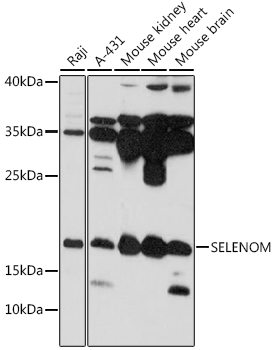Cell Biology Antibodies 7
Anti-SELENOM Antibody (CAB16660)
- SKU:
- CAB16660
- Product Type:
- Antibody
- Reactivity:
- Human
- Reactivity:
- Mouse
- Host Species:
- Rabbit
- Isotype:
- IgG
- Antibody Type:
- Polyclonal Antibody
- Research Area:
- Cell Biology
Description
| Antibody Name: | Anti-SELENOM Antibody |
| Antibody SKU: | CAB16660 |
| Antibody Size: | 20uL, 50uL, 100uL |
| Application: | WB |
| Reactivity: | Human, Mouse |
| Host Species: | Rabbit |
| Immunogen: | Recombinant fusion protein containing a sequence corresponding to amino acids 50-130 of human SELENOM (NP_536355.1). |
| Application: | WB |
| Recommended Dilution: | WB 1:500 - 1:2000 |
| Reactivity: | Human, Mouse |
| Positive Samples: | Raji, A-431, Mouse kidney, Mouse heart, Mouse brain |
| Immunogen: | Recombinant fusion protein containing a sequence corresponding to amino acids 50-130 of human SELENOM (NP_536355.1). |
| Purification Method: | Affinity purification |
| Storage Buffer: | Store at -20'C. Avoid freeze / thaw cycles. Buffer: PBS with 0.02% sodium azide, 50% glycerol, pH7.3. |
| Isotype: | IgG |
| Sequence: | LNRL KEVK AFVT QDIP FYHN LVMK HLPG ADPE LVLL GRRY EELE RIPL SEMT REEI NALV QELG FYRK AAPD AQVP PEYV W |
| Gene ID: | 140606 |
| Uniprot: | Q8WWX9 |
| Cellular Location: | |
| Calculated MW: | 16kDa |
| Observed MW: | 16kDa |
| Synonyms: | SELENOM, SELM, SEPM |
| Background: | The protein encoded by this gene belongs to the selenoprotein M/SEP15 family. The exact function of this protein is not known. It is localized in the perinuclear region, is highly expressed in the brain, and may be involved in neurodegenerative disorders. Transgenic mice with targeted deletion of this gene exhibit increased weight gain, suggesting a role for this gene in the regulation of body weight and energy metabolism. This protein is a selenoprotein, containing the rare amino acid selenocysteine (Sec). Sec is encoded by the UGA codon, which normally signals translation termination. The 3' UTRs of selenoprotein mRNAs contain a conserved stem-loop structure, designated the Sec insertion sequence (SECIS) element, that is necessary for the recognition of UGA as a Sec codon, rather than as a stop signal. |
| UniProt Protein Function: | SELM: May function as a thiol-disulfide oxidoreductase that participates in disulfide bond formation. Belongs to the selenoprotein M/SEP15 family. |
| UniProt Protein Details: | Protein type:Endoplasmic reticulum Chromosomal Location of Human Ortholog: 22q12.2 Cellular Component: nucleoplasm; Golgi apparatus; endoplasmic reticulum; perinuclear region of cytoplasm; cytoplasm |
| NCBI Summary: | This gene encodes a selenoprotein, which contains a selenocysteine (Sec) residue at its active site. The selenocysteine is encoded by the UGA codon that normally signals translation termination. The 3' UTR of selenoprotein genes have a common stem-loop structure, the sec insertion sequence (SECIS), that is necessary for the recognition of UGA as a Sec codon rather than as a stop signal. This gene is expressed in a variety of tissues, and the protein is localized to the perinuclear structures. [provided by RefSeq, Jul 2008] |
| UniProt Code: | Q8WWX9 |
| NCBI GenInfo Identifier: | 17975597 |
| NCBI Gene ID: | 140606 |
| NCBI Accession: | NP_536355.1 |
| UniProt Secondary Accession: | Q8WWX9,A8MPZ2, |
| UniProt Related Accession: | Q8WWX9 |
| Molecular Weight: | 17.9 kDa |
| NCBI Full Name: | selenoprotein M |
| NCBI Official Symbol: | SELM |
| NCBI Official Synonym Symbols: | SEPM |
| NCBI Protein Information: | selenoprotein M; selenoprotein SelM |
| UniProt Protein Name: | Selenoprotein M |
| Protein Family: | Selenoprotein |
| UniProt Gene Name: | SELM |
| UniProt Entry Name: | SELM_HUMAN |
View AllClose







